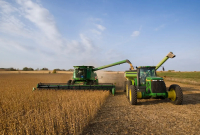Support strong Canadian climate journalism for 2025
Capping greenhouse gas emissions from Canada's cows, pigs, chickens and other farm animals, while bolstering support for plant-based food, could help the country reach its climate goals, a new analysis has found. But experts question whether the approach would encourage factory farming, infuriate farmers and further annoy a cash-strapped public.
The study, commissioned by animal rights group World Animal Protection, compared the effectiveness of reducing harmful emissions of Canada's carbon tax and clean fuel regulations against a cap on emissions or livestock production.
Where they’ve been tried in the past, politics and economics made policies like these fail in spectacular fashion.
Farming is responsible for about 12 per cent of Canada's emissions, well over half of which are generated by animals or fertilizers used on feed crops. Livestock counts have remained relatively stable in recent years, except for poultry, which has seen considerable growth.
Capping emissions is the cheapest and most efficient way for Canada to mitigate the climate impact of farms, followed by a cap on total animals raised. Aggressively bolstering the consumption of plant-based foods, without limiting animal production, was found to be the least effective and most expensive option.
"We need to reduce our climate emissions. Everyone knows that, and the Canadian agriculture sector is not doing its part," said Lynn Kavanagh, farming campaign manager for World Animal Protection. She cited a recent federal Commissioner of the Environment report that found the government doesn't have a plan to reduce the sector's emissions.
Capping how much Canada's livestock and dairy sectors can emit and implementing a 50 per cent reduction compared to 2005 levels by 2050 would in practice reduce the number of animals by about half, the research found. It would also push farmers and agribusinesses to invest more in emission-reduction technologies like biodigesters, electric heating and vehicles.
But experts question if the approach is even desirable – or politically feasible.
In 2022, New Zealand became the first country in the world to propose capping emissions from livestock. The backlash was swift, with some observers linking the policy to the country's political swing to the right. In the Netherlands, a proposal for the government to buy out livestock farmers, as part of an emissions-reduction plan, generated years of protest and fuelled authoritarian conspiracies there and abroad.
In Canada, a 2022 federal proposal for a voluntary plan to reduce emissions linked to fertilizers led to swift political backlash. Conservatives accused the government of attacking farmers, with conspiracy theorists going even further to falsely claim on social media the proposal was part of an authoritarian plot. (It is not.)
"It is tricky, it is challenging, and there's going to be probably pushback for sure," Kavanagh acknowledged. "We don't want to leave farmers out of the equation."
She said the group "would recommend" that any effort to create an agricultural emissions cap be rejoined by a slew of programs to ease the transition cost to farmers. Canada has a suite of programs designed to help farmers reduce emissions, from improving the carbon stored in farmland to adopting more sustainable farm technologies.
Ryan Katz-Rosene, a political economist at the University of Ottawa and farmer, echoed those concerns.
"The big red herring here is feasibility," he said, because devising policies to enact this kind of rule would be difficult. There are only a handful of oil and gas producers and facilities in Canada, making it relatively easy to measure their emissions and ensure they don't breach an emissions cap. But Canada has thousands of farms, and devising a strategy to measure and cap their emissions would be technically challenging.
Another problem is ensuring that rangeland currently devoted to raising cattle wouldn't be used for more emissions-intensive purposes than before, said Darrin Qualman, director of climate crisis policy and action for the National Farmers Union. Cattle ranching can help protect grasslands from being dug up and turned into fields for crops, which themselves can generate greenhouse gas emissions if they are over-fertilized with nitrogen.
A cap on livestock emissions or production would only work well if rejoined by measures that encourage farmers and ranchers to ensure that land previously used for livestock would be stewarded to sequester carbon in the soil, he explained.
Katz-Rosene echoed similar concerns, adding that an emissions cap might actually bolster factory farms and feedlots. If the only metric is emissions reductions, raising livestock in feedlots emits fewer harmful greenhouse gases than growing them on pasture because the animals grow faster and live shorter lives. But the approach comes with a host of environmental and animal welfare problems, he said.
But he warned the biggest hurdle is convincing Canadians – and politicians – that efforts to regulate livestock emissions are worth it.
"We're in a context where there's so much working against [climate action] in our current political climate that the idea of intentionally hampering the cost of food, or access to meat and animal products – it's so politically fraught," he said






Comments
This false dichotomy really annoys me. It's presented as either business as usual or no animal products and usually promoted by the animal rights lobby who are using climate change as a method to force their opinions on others. There's no consideration of alternative approaches. It's a distraction away from the real villain in this country, the oil and gas industry.
I can't imagine a government in Canada foolish enough to propose a cap on livestock emissions.
A link to the study would have been appreciated.
Policies to Promote Plant-Based Food Production and Consumption in Canada
Executive summary: https://www.worldanimalprotection.ca/siteassets/reports-pdfs/navius-rep…
Full report: https://www.worldanimalprotection.ca/siteassets/reports-pdfs/navius-rep…
The study notes that there are other beneficial environmental effects, beyond reducing greenhouse gas emissions, of shifting to more plant-based food consumption:
"Currently, agriculture land accounts for around half of all habitable land on earth, where 83% is used for animal agriculture including feed crops. Switching to a more plant-based diet would partially free up these land areas -- including marginal lands that are often inefficient at producing food, but ecologically valuable -- which could become available for conservation, restoration, and reforestation. In addition, agriculture is the leading cause of biodiversity degradation globally, mainly due to the production of crops needed for animal feed. Research suggests that this degraded land can recover its original carbon stocks and biodiversity levels if transitioned away from agricultural land. Lastly, animal agriculture uses 43% of all the water consumed by the global food system and is responsible for a disproportional amount of water pollution. Switching to a lower animal consumption diet would therefore reduce not only greenhouse gas emissions, as quantified in this analysis, but could also reduce land use, water consumption, and water pollution, while increasing biodiversity levels. There are also substantial health benefits from reducing animal consumption."
At some point, we'll collectively need to get serious about stopping GHG emissions; hopefully, it will be before we cross tipping points that make the current catastrophe into something much worse. Oil and gas is the correct main focus, but even if all fossil fuel burning stopped, emissions from animal agriculture would still ruin the planet - just more slowly.
Canadians won't support things they don't understand or don't think is fair. There is a lot of work to be done in educating people - but it will be impossible while governments do exactly the wrong things (TMX, Hwy 413, fracking permits), which all tell people that we've got no emergency.
Denmark just passed legislation regarding agriculture - including "the world’s first climate tax on agriculture". They elect their federal government through proportional representation and the legislation was widely backed.
https://www.arc2020.eu/political-deal-reached-on-denmarks-green-tripart…
Farming is not a subsistence activity anymore, it is a business, a way to make money. A noble way!
You must show farmers how to improve their bottom line by avoiding a waste of energy in the form of methane and nitrous oxide. If you can invent methods and demonstrate how to do that, and that it will be good for the environment, farmers will follow.
If you penalize them, there is no way that they accept your ideas.